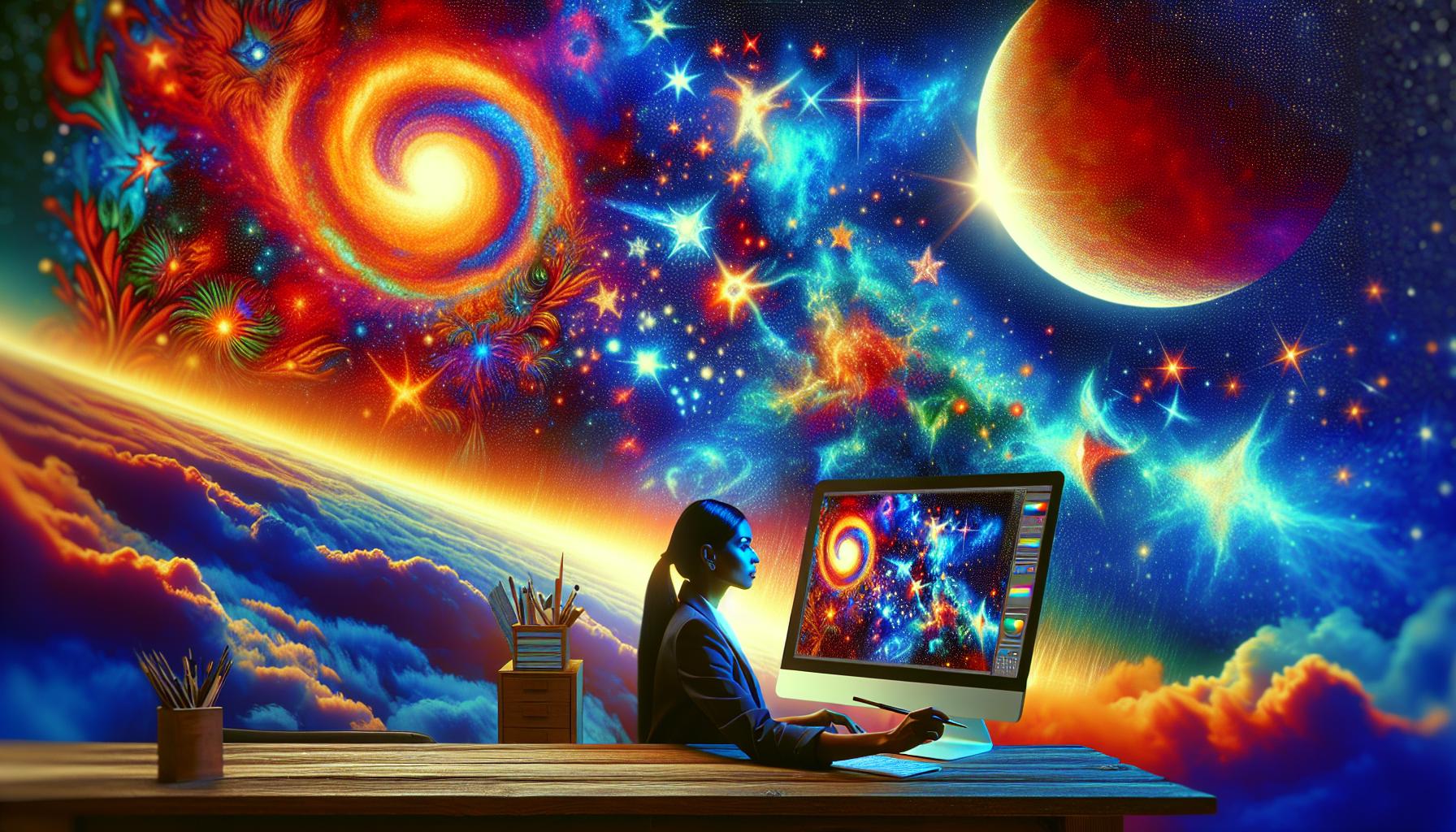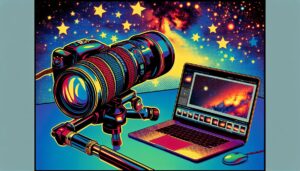This site contains affiliate links to products. I may receive a commission for purchases made through these links.
Astrophotography is a thrilling hobby that combines the vast beauty of the cosmos with the art of photography. But capturing those stunning images of twinkling stars and distant galaxies is just the first step. The magic truly happens in the editing process.
I’ve spent years perfecting my astrophotography editing techniques. Now, I’m here to share my secrets with you. From enhancing starlight to bringing out the colors of distant galaxies, I’ll guide you through the process.
Understanding how to edit your astrophotography can be the difference between a good image and an awe-inspiring one. With the right tools and techniques, you’ll be able to transform your night sky images into breathtaking masterpieces. So let’s dive into the world of astrophotography editing together.
Why editing is important in astrophotography
Editing is crucial in astrophotography for various reasons. First, the shots taken by astrophotographers often contain vast amounts of data, from the bright lights of distant stars to the subtle shades of far-flung galaxies. However, this data can’t all be seen in raw, unedited photos. It’s hidden beneath layers of darkness, waiting for skilled hands to uncover. That’s where editing comes in.
Through editing, I can increase the visibility of this celestial data. I can enhance the dynamic range, bring out the colors of galaxies, and sharpen the details of stars. I can also minimize the noise, correct the color balance, and adjust the exposure. With the right editing skills, I can make the unseen seen.
Editing is also crucial in astrophotography because it helps to bring my interpretation into the image. Each astrophotographer views the night sky in a unique way and editing allows me to tell my story, from my perspective. Maybe I want to focus on a nebula’s intricate patterns or highlight a constellation’s alignment. With a few tweaks in the editing process, I can achieve these desired effects.
But let’s not forget this – editing is an art. It’s not about blindly following instructions or using presets. It’s about understanding the essence of astrophotography and knowing what techniques to apply. It’s about mastering the science behind image editing software, knowing when to boost the color balance, and when to dial it down.
So, editing isn’t just a part of astrophotography. It’s a significant part that can bring a whole new dimension to the images. Just remember, every great astrophotograph requires a great amount of editing. With the right skills and techniques, any astrophotographer can transform their shots into breathtaking astronomical art.
Required tools for editing astrophotography
One fundamental tool for any astrophotographer is editing software. There are various software applications available, each with its unique strengths. Adobe Photoshop and Lightroom remain industry favorites for their extensive features and flexibility. They offer layers, catalogs, color correction, noise reduction and more. These tools give us, as astrophotographers, the potential to transform our images in almost any way we envision.
For those interested in free software, GIMP (GNU Image Manipulation Program) provides similar functionality without the price tag. It’s a robust editing platform ideal for beginner astrophotographers who are still learning the ropes.
Astrophotography-specific software such as PixInsight and DeepSkyStacker shouldn’t be overlooked. PixInsight offers superior noise reduction techniques and has an edge in advanced astrophotography processing. In contrast, DeepSkyStacker excels in stacking multiple images for noise reduction and increased detail.
Finally, a few plugins can further streamline the editing process. Gradient Xterminator for Photoshop is great for gradient removal. And the Noise Ninja for Lightroom can work wonders in noise reduction.
Here’s a quick summary of these tools for astrophotographers:
| Tools | Usual Application |
|---|---|
| Adobe Photoshop | Layers, Catalogs, Color Correction |
| Adobe Lightroom | Noise Reduction, Advanced Corrections |
| GIMP | Alternative to Adobe Products without the cost |
| PixInsight | Superior noise reduction, Advanced processing |
| DeepSkyStacker | Image Stacking for Noise Reduction, Increased Detail |
| Gradient Xterminator (PS Plugin) | Gradient Removal |
| Noise Ninja (LR Plugin) | Noise Reduction |
Preparing your images for editing
First off, the format you shoot in is integral. I always suggest shooting in RAW format. RAW files capture all image data recorded by your camera’s sensor making it an indispensable asset for any astrophotography edit. They contain the most information enabling you to make significant changes without the risk of degrading image quality.
Once you’ve shot in RAW, the very first task in preparing your images for editing is ‘Stacking’. In astrophotography, stacking involves layering multiple shots of the same scene in order to reduce digital noise and enhance the signal. This process improves the clarity of your images making them easier to edit. There is specialist software available like DeepSkyStacker which I’ve previously mentioned and recommend for this job.
Once you’ve stacked your images, the cleaning process is next. All astrophotography images will have some unwanted elements that might manifest as stray light, dust speckles, or even a satellite passing through. Use your software of choice to manually clean some of these elements resulting in a cleaner workspace for your starry masterpiece.
Moreover, consider normalizing brightness levels across your images. I do recommend using programs like Lightroom or PixInsight for this. Why do we do this? It helps level out light disparities, making your images uniform and ready for the editing process.
The last step in prepping your images would be to align them. In astrophotography, due to the earth’s rotation, stars will appear to move across the sky in long exposures. Alignment compensates this movement making sure your stars are in their correct positions. Canon’s Digital Photo Professional and Adobe Photoshop are great tools for this task.
Understand that your preparation work is going to look different depending on your image. You might spend more time on one step than another or discard it entirely. That’s completely fine. Remember, it’s about enhancing your astrophotography, not following a strict formula.
Basic editing techniques in astrophotography
Before diving into specific techniques, let’s first understand the essence of editing astrophotography. At its core, it’s about bringing out the best in your celestial shots, removing unnecessary distractions, and accentuating the details you want to highlight. Remember, the beauty of astrophotography editing lies in the flexibility it provides. The methods I’m going to talk about aren’t set in stone; feel free to experiment and tweak them according to your creative needs.
The first technique we’ll discuss is Curve Adjustment. This tool, found in most editing software, helps control the brightness and contrast of your image. Working with curve adjustments can help to reveal more detail from stars and galaxies captured in your shots.
Next up is the Levels Adjustment tool. This feature adjusts the tone of the image, enhancing the difference between light and dark. These adjustments bring out the finer points of galaxies, nebulae, and other faint celestial bodies.
One of the most crucial techniques is, undoubtedly, Noise Reduction. Since astrophotography involves long exposures often and high ISOs, noise can become a significant annoyance. Noise Reduction tools help to clear this clatter, providing cleaner, clearer cosmic imagery.
Last, but not least, is the use of Sharpening tools. Once you’re satisfied with the brightness, contrast, and noise level, sharpening tools help to define stars and other space architecture against the night sky.
Advanced editing techniques for astrophotography
While standard editing techniques like curve adjustments and noise reduction are a solid start, advanced editing lets you take your astrophotography to the next level.
Among these high-level techniques are color correction, detail extraction, and the use of layer masks. Color correction helps to enhance the natural hues of the cosmos. In the vast expanse of space, various celestial bodies emit diverse, vibrant colors that aren’t visible to the naked eye. With color correction, these hidden marvels can be highlighted and brought to life in your photos. For astrophotography, I’m fond of the selective color tool and hue/saturation sliders in many editing programs.
Enhancing detail is a meticulous process. It involves careful attention to celestial bodies, making them ‘pop’ against the starry background. Techniques include unsharp masking, high-pass filters, or even a ‘smart sharpen’ feature if your editing software has one.
Layer masks can be seen as the ‘secret sauce’ of advanced editing. They allow for selective editing without affecting the entire image. By using them, you can adjust the levels of a single star cluster, enhance the color of a galaxy, or extract detail on a nebula without disrupting the balance of the rest of the image.
These advanced techniques, when utilized correctly, open a world of possibilities for visual storytelling. Through the manipulation of colors, layers, and details, one can create an immersive visual of the cosmos that gives justice to the awe-inspiring beauty of space.
Conclusion
So there you have it. Sharpening and noise reduction are key to enhancing your astrophotography. It’s all about finding that perfect balance to maintain image clarity and detail. Adobe Photoshop and Lightroom are your allies in this process, offering a range of tools to refine your images.
But remember, it’s not just about the tools. It’s about your vision, your creativity, and your willingness to experiment. So don’t be afraid to play around and see what works for you. The universe is a stunning, ever-changing canvas. With practice and patience, you’ll capture its magnificence in ways that truly reflect your unique perspective as an astrophotographer. Here’s to your journey in capturing the cosmos!
Don’t forget to subscribe to our newsletter where you’ll find the latest cosmic discoveries, expert stargazing tips, and exclusive subscriber deals. Embark on your cosmic journey if you haven’t already!



